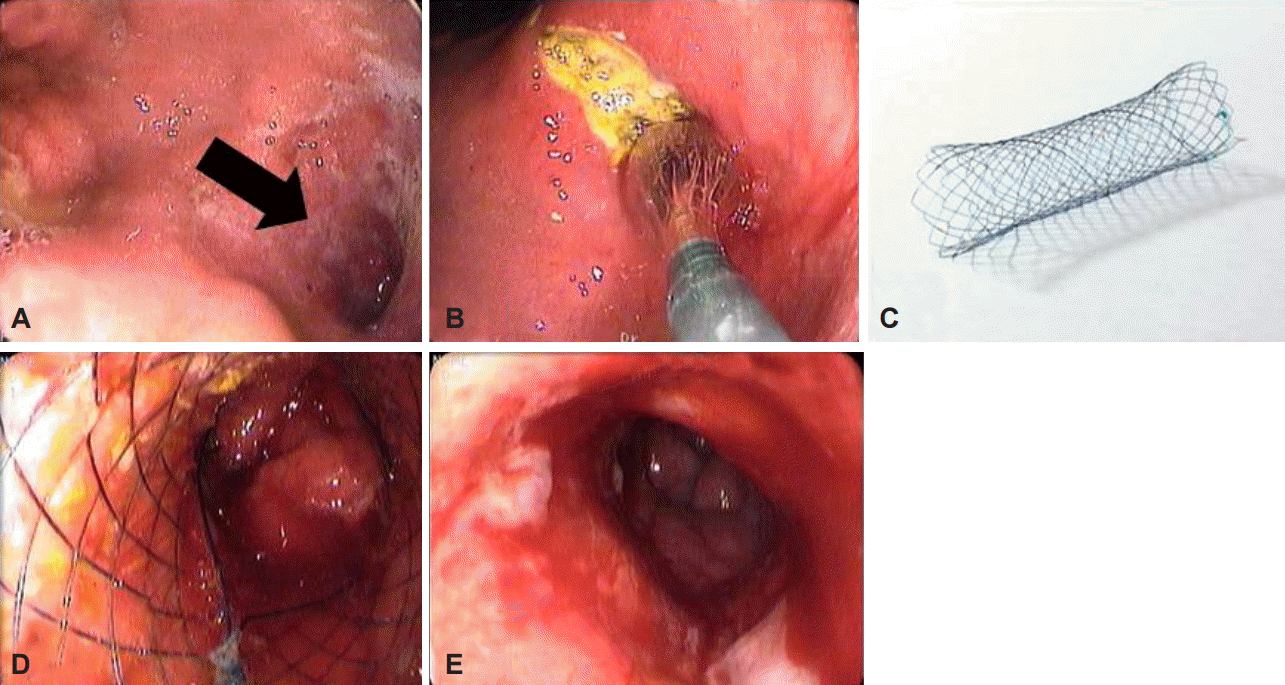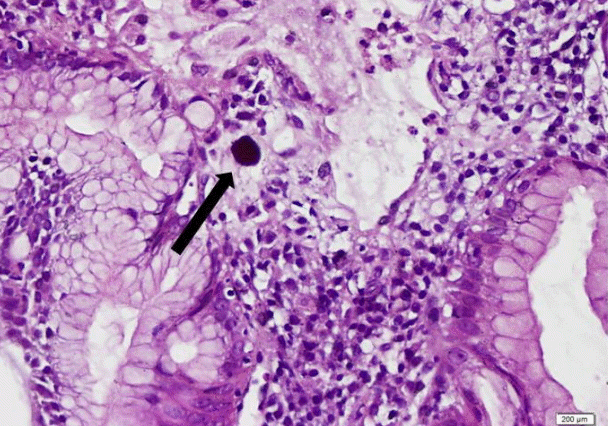A 58-year-old man with liver metastasis from a neuroendocrine tumor was referred to the nuclear medicine department for treatment with yttrium. Pre-treatment hepatic angiography revealed normal arterial anatomy, and screening with tagged albumin showed the absence of hepatopulmonary shunt. The patient was treated with intra-arterial yttrium-90 microsphere embolization. The patient did not have any GI symptoms before undergoing the procedure; however, he experienced epigastric pain, nausea, and vomiting 3 weeks after undergoing yttrium-90 SIRT. He lost 4 kg weight during this period. Upper GI endoscopy showed a geographic-shaped antropyloric ulcer accompanied by exudation and stricture at the antropyloric region, with strong resistance against the passage of the endoscope through the stricture (
Fig. 1A). Multiple biopsies taken from the ulcer margin demonstrated dark microspheres in the deep layer of the lamina propria (yttrium particles), severe reactive glandular atypia, and denudated friable mucosa consistent with radiation injury. No sign of helicobacter pylori infection or malignancy was observed in the biopsy specimens (
Fig. 2). The patient had no history of steroid or nonsteroidal anti-inflammatory drug intake. A PPI (esomeprazole 40 mg) was started twice a day for 10 days, but this had no apparent effect on the patient’s nausea, vomiting, and epigastric pain. Therefore, endoscopic balloon dilation was performed with a 15-mm through-the-scope (TTS) balloon (2×60 seconds; Boston Scientific, Watertown, MA USA), and the balloon was easily moved back and forth before it was removed after dilation (
Fig. 1B). The patient’s response was not sufficient a week after balloon dilation, so a partially covered TTS (
Fig. 1C) (SEMS; Hanarostent, 20 mm/110 mm partially covered SEMS Duodenum/Pylorus Lasso [NCN; M.I. TECH, Seoul, Korea]) was placed under endoscopic (
Fig. 1D) and fluoroscopic control. The patient’s oral intake was assessed by using GOO scoring [
6]. The pre-stenting GOO scoring was 1, whereas the score on poststenting day 3 was calculated as 3. An endoscopic examination was performed 3 months later, and the stent was retracted by grabbing the stent lasso with grasping forceps (
Fig. 1E). During the same endoscopic examination, the ulcer was observed to have significantly healed. Stent migration or complications such as perforation or hemorrhage did not occur. Symptoms such as nausea and vomiting were not present at the follow-up visits at 2, 3, and 6 months after stent removal. Endoscopic examination at the 6-month follow-up visit revealed a lack of both food retention in the stomach and ulceration, and the antropyloric junction was open; further, the patient had gained 10 kg.
 | Fig. 1.(A) Endoscopy shows gastric ulcer and outlet obstruction (arrow), (B) endoscopic view of balloon dilation (15 mm in diameter). (C) Hanarostent, a partially covered self-expendable metallic stent Duodenum/Pylorus Lasso (NCN; M.I. TECH), (D) proximal view of an opened stent after stenting, and (E) endoscopic view after stent removal. 
|
 | Fig. 2.Histological appearance of the biopsy (H&E stain, ×200) showing the presence of yttrium-90 resin microspheres (arrow) in the lamina propria. 
|





 PDF
PDF Citation
Citation Print
Print



 XML Download
XML Download